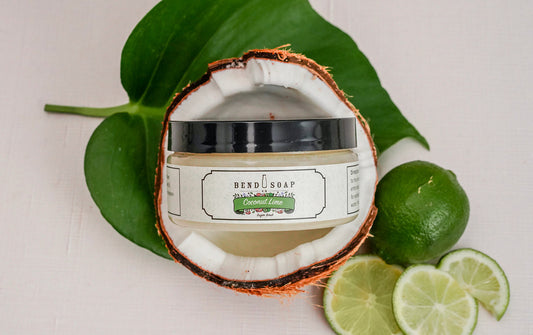As a regular shaver, it’s likely that you understand the value in having a shaving cream or gel in the shower. Aside from helping your razor glide along as you shave, a shaving cream can offer the following benefits:
- Cleanses and moisturizes the skin.
- Acts as a buffer between your skin and hair, allowing you to get a closer shave while preventing nicks and cuts.
- Helps you track where we’ve already run your blade.
But there’s a problem with traditional shaving creams and gels, namely that they’re often made with toxic ingredients that can damage the skin and cause a host of other issues, entering through your body when your pores are open and vulnerable! At Bend Soap Company, our mission is to create products that are safe and healthy; products that people can trust. And when it comes to shaving, we have the perfect product to replace those chemical laden shaving creams and gels that may be sitting in your shower as you read this.
We’re going to explain exactly how you can use our goat milk soap to get an incredible shave (yes, really!), but first, let’s dig deeper into why you should ditch the shaving creams for good in the first place.
The Problems with Traditional Shaving Creams
While the majority of shaving creams consist of water as the main ingredient, the remaining ingredients are for five general purposes:
- The base of the creamy liquid.
- To lather up or foam the liquid.
- To bind the liquid and the foaming agent, otherwise known as emulsifiers.
- To propel the foam out of the canister (aerosols).
- To scent the cream.
The list of ingredients in a standard bottle of shaving cream read like a who’s who of common — but potentially dangerous — chemicals.
#1 The base of the creamy liquid
To start, mineral oil is often found in shaving creams which is scary because it's a derivative of petroleum (AKA gasoline!). Propylene glycol — another common ingredient — is found in brake fluid and antifreeze. Then there are the GMO oils like canola, soy, and other “vegetable” oils (which can be anything from canola to corn oil) that are potentially genetically modified and even banned in other parts of the world.
#2 Lathering and foaming chemicals
There’s sodium lauryl sulfate, also known as SLS, which is a surfactant that helps shaving creams achieve their foamy state. Research has shown that SLS compounds often mimic estrogen, an important function in the female reproductive system. There is evidence that it can also irritate the skin. Depending on how it’s processed, this toxic substance could also house a known carcinogen called ethylene oxide.
#3 Emulsifiers
Triethanolamine, also known as TEA, along with cousins diethanolamine (DEA) and monoethanolamine (MEA), are all emulsifying agents, meaning that they help mix liquids and fats. According to the Environmental Working Group, this controversial toxin is a known allergen that can cause skin, immune, and respiratory irritation.
#4 Aerosols
Aerosol products have been used for generations, but they’re dangerous for both your health and the environment. Used to help propel the cream out of the can, many aerosol products contain highly toxic chemicals like butane, xylene and formaldehyde. These toxic ingredients also include neurotoxins and carcinogens that are extremely hazardous for adults, kids, and even the family pets.
#5 Artificial Fragrances
Finally, one of the most common ingredients found in shaving creams — that’s also found in nearly all traditional cosmetic products — is fragrance. You may love the delicate scent that your favorite product leaves behind, but you probably don’t love the fact that fragrances are typically made from a combination of separate chemicals that don’t actually have to be disclosed on the label. What’s more, this secret mix of ingredients — culled from a list of more than 3,000 potential compounds — is often responsible for a number of adverse reactions, including skin irritation, headaches, respiratory issues, and many others.
In the US, companies can use the term “fragrance” or “parfum” to hide a variety of toxic chemicals. Designed to help companies protect their “trade secrets”, this term is now a convenient catch-all listing on ingredient labels for almost any chemical or toxin a company would rather not outright disclose. Typically, that means an undesirable synthetic.
Why Shaving Soaps Are Better Than Shaving Creams & Gels
Despite these dangers, shaving creams and gels are still the most widely used shaving products. But we hope this continues to change!
Shaving soaps have a long history of use that dates back to the mid-19th century. Back then, manufacturers had yet to embark on the technological advances that would lead to the aerosol cans that house most shaving creams, so shaving soaps were really the only option. And thanks to the thick, creamy lather they produced, they were actually quite effective.
Even today in the 21st century, shaving soaps present a compelling list of benefits. They’re small and take up much less space for storing or packing during travel. They are much better for the environment, as they don’t come packaged in cans, bottles, or tubes. Because they come with much less packaging, they’re cheaper to manufacture — a savings that is often passed to the consumer via lower prices.
But most importantly, shaving soap eliminates the use of aerosols, emulsifiers, and synthetic foaming agents. And when you use Bend Soap goat milk soap, you’ll also avoid all propylene glycol, GMO oils, mineral oil, and fragrances. Your skin is worth the switch. Perhaps most enjoyably, shaving soaps provide a really, really good shave without the risk of exposing yourself to a laundry list of toxins.
Where shaving soaps really shine is that when the lather is made perfectly, you can get a much richer and slicker lubrication when compared to a shaving cream,” says Shawn Burns, founder and editor of men’s grooming site Tools of Men. “This is why shaving soaps are preferred by men who really want full control over their shaving routine.”

How to Use Goat Milk Soap for a Clean and Effective Shave
If you’re only familiar with shaving creams and gels, you may be surprised to find that using a shaving soap is also easy and convenient. And for minimalists, you can use the same soap to wash, shave, AND shampoo (yes, you can even wash your hair with goat milk soap).
For ladies looking to shave their legs, armpits or bikini areas, simply rub the bar between your hand until a satisfying lather develops, and then apply it to the skin. Or rub the bar directly on the skin, lathering as you go. If you like extra exfoliation, consider adding the bar to a natural loofah bag to the mix and enjoy the extra suds.
For men, rub the wet soap between your hands or with a shaving brush and work it into a rich, thick lather. Apply the lather directly to your face, massaging it into the skin so that it effectively softens the hair. After shaving, gently rinse away any remaining soap and continue on with your grooming routine.
The amazing lather and pure quality is what makes using our goat milk soap bars so ideal. Because our bars are formulated with only all-natural ingredients (our Unscented Goat Milk Soap is made with just four all-natural ingredients!), you can trust that they won’t harm or irritate even the most sensitive areas. And unlike many other “natural” bars of soap, you won’t experience a slimy feel and your skin won’t feel tight or dry.
The best part? The fresh goat milk, olive oil, and coconut oil in our soaps combine to create a luxurious and nourishing product that leaves the skin soft and supple.
A 3-Step Shaving Routine from Bend Soap Co.
Ready to ditch the cream and transform your shaving routine with goat milk soap? Here’s a look at our recommended three-step process that will ensure the perfect shave every time.
Step 1: Exfoliate
If you’ve been unsure about whether you should exfoliate before or after you shave, allow us to set the record straight. Exfoliating before you shave clears away the dead skin cells that can clog your razor — preventing that close shave that you want! — and potentially lead to ingrown hairs. The key is to avoid exfoliating with a product that contains coffee grounds, microbeads, or any other harsh, sharp ingredients that can tear the skin before shaving (more on that here).
For this part of the process, we suggest using one of our all-natural sugar and salt scrubs. They are super effective in sloughing away rough, dry, and dead skin, but they’re also gentle enough to use on your face.
Step 2: Shave
Now that your skin is clean and smooth, you’re ready to shave. Grab your favorite scent of goat milk soap and lather up! Not sure which bar to start with first? The best thing about our bars of goat milk soap is that they’re all made with the same base of four all-natural ingredients — fresh goats milk, coconut oil, olive oil, and sustainably sourced red palm oil — with essential oils added to some for added aromatherapeutic benefits. This means that you’ll never have to compromise great smelling shaving cream for toxic ingredients. Hint of Lavender Goat Milk Soap is a relaxing scent to use after a long day. Mt. Bachelor Pine Goat Milk Soap is a fresh, masculine-smelling scent men tend to gravitate towards. For ultra sensitive skin, grab a bar of our Unscented Goat Milk Soap.
Be sure to keep working the soap between your hands or against your skin until you get a velvety lather that covers the entire area you’re planning to shave. The blade of your shaver will glide much easier over skin that’s fully covered in the lather, but skimping on this step can create a rough, uneven shave that leads to knicks.
Step 3: Moisturize
Though it’s the last step in the shaving process, moisturizing is still incredibly important. Your skin can dry out after shaving, so making sure it’s hydrated will prevent itching and irritation while also helping your shave last longer. It’s important to avoid using after shave creams and moisturizers that contain alcohols, preservatives, parabens, and other harmful ingredients that can cause irritation.
Formulated with a base of goat milk, shea butter, and water, our goat milk lotions are all-natural and hypoallergenic. They’re also deeply nourishing, providing you with all-day hydration. Some of our favorite scents include Almond Delight and Sweet Orange, but we encourage you to try them all!
Back to You
Conventional shaving creams crowd the shelves at many stores and continue to be high-selling products. Are big-name brand cans of aerosol shaving creams more convenient (and even a little more fun) to use? Maybe. Do they provide you with naturally smooth skin without the toxins? Far from it.
Shaving is an important part of many of our lives and a necessary step in our personal care routines. But there’s a right and a wrong way to shave, and it all comes down to the products you use. We encourage you to swap out your shaving creams and gels for the thick, nourishing lather that you can get from a bar of all-natural goat milk soap. Your skin will thank you!
Sign up to receive regular Toss the Toxins emails with educational information and tips from your friends at Bend Soap Company.





11 comments
I ditched my old soap and shaving process and began using the Bend Soap. I noticed that my legs were not dry after I used the soap for a week. I enjoyed ready why from this article. I also picked up the benefits of the loofah .